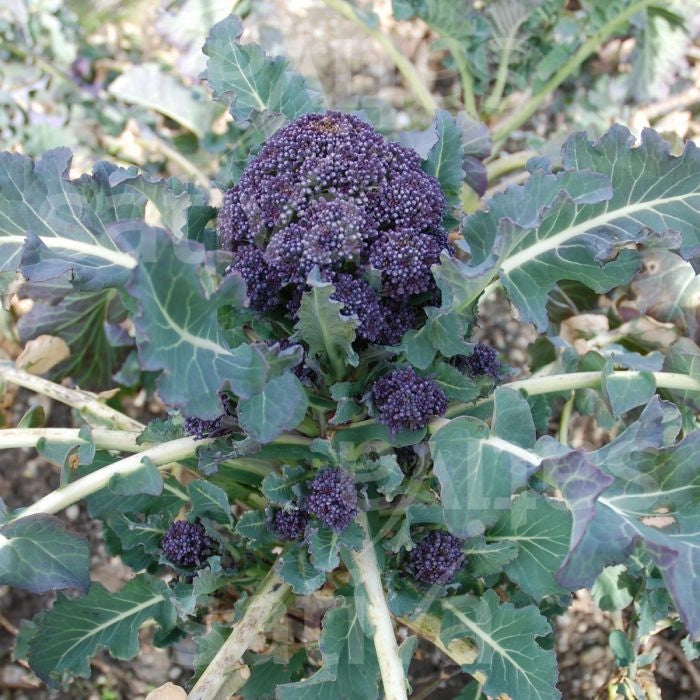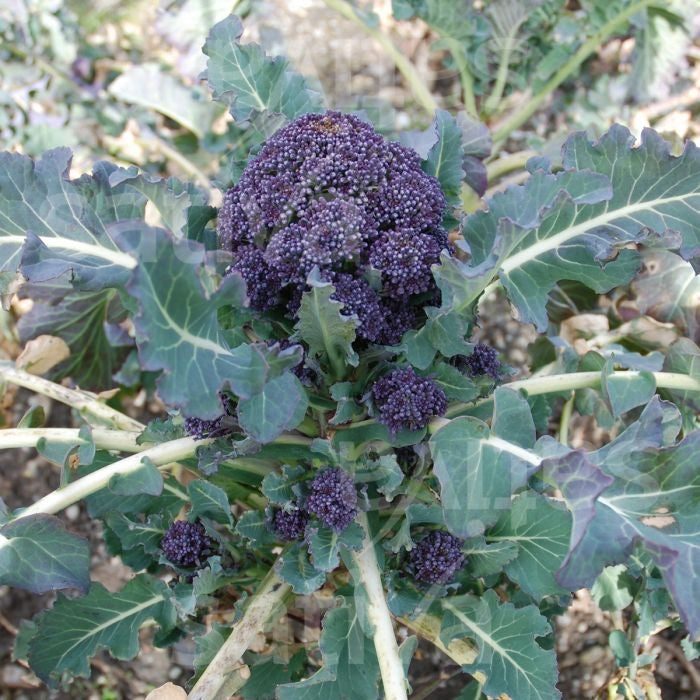BROCCOLI CABBAGE FROM RICACCI - ko25
Have a question?

BROCCOLI CABBAGE FROM RICACCI - ko25
Dettagli
Scientific name: Brassica oleracea L. conv. botrytis (L.)
Family: Cruciferae – Brassicaceae
Brief history and botanical notes on the plant
Broccoli (Brassica oleracea L. conv. botrytis (L.) Alef. var. cymosa Duch.) differs little from cauliflower: it belongs to the Cruciferae family – Brassicaceae, tribe: Brassiceae –. Species: Brassica oleracea L. var. botrytis L.. Commonly the head (the set of florets) is called the top, hence probably the name "cymosa".
Broccoli, although it belongs to the cauliflower species, is distinguished by its shoots or secondary inflorescences. It was probably precisely this peculiarity that determined the name of broccoli (brocco is the disused name for sprout). It is one of the oldest horticultural vegetables.
Known since ancient times, it was considered sacred by the Greeks; the Romans used it to treat the most varied diseases and ate it raw, before banquets, to help the body absorb alcohol better. In Italy it first established itself in Tuscany and the south. The countries in which its cultivation is most widespread are India, China, France, Italy and the United States.
Cauliflower is a biennial herbaceous plant and has a not very deep taproot. On the erect stem (15 to 50 cm long) there are a few dozen ribbed leaves, of which the outermost ones are larger, of a more or less intense green color sometimes tending towards grey, pruinose, while the internal ones are yellowish in colour. or light green and often completely cover the edible part.
The edible part, the corymb, an inflorescence derived from a hypertrophied apical bud, is the result of the repeated branching of the terminal portion of the main axis of the plant. The corymb can take very different shapes. The convex upper surface of the corymb is formed by a very high number of apical meristems.
The actual inflorescence is raceme and comes from the elongation of the fleshy peduncles of the corymb. As these peduncles lengthen, they branch several times. The flowers of the first branches abort and only those of the fourth-eighth order branching onwards are fertile. The flowers are yellow and typical of cruciferous plants. Heterogamous fertilization is the prevalent one. The fruits are silique, of different shape and length; they can contain up to over 25 seeds, round, with a diameter varying from 1 to 2.5 mm, reddish-brown or almost shiny bluish.

Needs
It prefers areas with a cool and humid climate, but the numerous existing varieties allow its cultivation throughout Italy, with greater attention to the temperature in the north, which appears to be the most important climatic factor, both during the transition phase from vegetative to reproductive and before and after it. For early cultivars the optimal temperature for the formation of corymbs is around 17°C. With temperatures above 20°C the transition to the reproductive phase is delayed and the quality of the corymbs becomes poor. Even low temperatures can damage the plant during the various stages in which it is found. If the plant has formed 6-8 leaflets and is subjected to low temperatures, you can have "blind" plants, i.e. without inflorescence. Frost causes the lumps that form the edible part to boil.
It requires medium-textured, deep, fresh soil, rich in organic substance and well drained. It fears acidic soils and boron deficiency.
It benefits from intercropping with many plants, such as lettuce and spinach, tomato, celery, aromatic and medicinal herbs in general. Avoid combining with garlic and onion.
Sowing and transplanting times
Cultivation takes place at different times of the year, depending on the location and the cultivars used. Single succession must be strictly avoided, especially if vegetation residues are not eliminated, especially if affected by diseases. Even if direct sowing provides excellent results, today, particularly with the use of hybrids, seedlings grown in nurseries in honeycomb containers are used, subsequently transplanted from July to September. Excellent rotation with legumes.
Depending on the size of the plants there are different planting densities. The late varieties are larger than the early ones, so the planting distances vary from 60 to 100 cm between the rows and 40-70 cm along the rows, with a density of seedlings varying from 15,000 to 30,000 per hectare.
Processing
They require deep tillage of the soil to facilitate the development of the root system.
Fertilization
For the production of 10 tons of corymbs the plants remove approximately 130 kg of
nitrogen, 40 phosphorus, 140 potassium and 50 CaO and 7 Mg. It is greedy for nitrogen and mature organic matter, represented by vegetable compost or mature manure.
Products
For marketing, the broccoli is prepared leafed (only the outermost large leaves are removed, while the others are left to protect the corymb and just sprouted at the terminal part), crowned (only the outermost large leaves are removed, while the others are cut a maximum of about 3 cm above the head), defoliated (all leaves are removed except for the innermost, young, tender ones), naked (all leaves are removed)
Broccolo can be eaten raw, seasoned with oil, salt and lemon; or cooked in various ways: boiled and sautéed in a pan, fried in batter or used in soups and stews.
Cultural care
The control of wild herbs can be carried out in the first period of the cycle with mechanical means.
It is important to eliminate crop residues at the end of the cycle.
Irrigation
It requires constant availability of water; therefore, in summer-autumn crops, it requires irrigation.
Adversity
We remember Alternariosis (Alternaria brassicae), Cruciferous hernia (Plasmodiophora brassicae), basal rot (Sclerotinia spp., Rhizoctonia solani, Phoma lingam) and downy mildew (Peronospora brassicae, Peronospora parasitica). Also susceptible to some bacteria (Xanthomonas campestris, Erwinia carotovora).
The most important animal parasites are aphids (Myzus persicae, Brevicoryne brassicae), noctules, cabbage flies (Mamestra brassicae, Mamestra oleracea, Pieris brassicae), wire weevils (Agriotes spp.), altica (Phyllotreta spp.), weevils (Baris spp., Ceuthorrhyncus spp.) and the cabbage fly (Delia radicum).
Defense products
Downy mildew can be prevented by spraying with horsetail decoction.
Hernia of cruciferous plants and numerous basal rots and bacteriosis are strongly limited by correct rotations (avoid the cultivation of any cruciferous plant for 3-4 years on the same plot), by the distribution of lithotamnium on the soil before transplanting and by spraying with horsetail decoction .
Bacillus thuringiensis and neem oil can be used to control night moths and cabbage flies.
Altica can be a serious problem especially in the case of compact and dry soil; it can be contained in small vegetable gardens with broom branches and by dusting the vegetation with lithotamnium and bentonite. In case of strong attacks, use pyrethrum.
The control of the cabbage fly is above all preventive and essentially consists in the destruction of vegetation residues, possibly also removing the surrounding earth. Intra-sowing, for example with clover, hinders oviposition.
Production and collection
Approximately 4kg of broccoli are produced per square meter. However, the dimensions and weight of the corymbs vary considerably depending on the cultivar: in some old cultivars they exceed 30 cm in diameter and 3-5 kg in weight; in those normally used today the defoliated corymbs generally do not exceed 1.5 kg.
The harvest is graduated for all the classic Italian cultivars and goes from October to May.
The corymbs are harvested when they are compact and in any case before the individual florets or florets that make up the corymb begin to separate. Since ripening does not occur at the same time, 3-6 harvests are required. The cutting of the corymbs can be done with or without leaves.
Nutritional values
Cauliflower is very rich in water (more than 90%), but with a non-negligible energy value
(25-30 calories 100g of edible part; 2% protein). It has a good content of vitamin C, potassium, phosphorus and calcium. Furthermore, it contains various sulfur compounds which produce the characteristic odor during cooking and cause some digestion difficulties but, like other cruciferous vegetables (broccoli in particular), it has compounds which appear to have an anti-tumour action. It has a large amount of fiber which helps the work of the intestine and wards off tumors related to the digestive system. Being very satiating they are useful in a low-calorie diet.
There are numerous therapeutic uses as an anti-anemic, emollient, diuretic, healing, purifying, vermifuge.
Family and variety
The cultivars are distinguished based on whether or not cold is required for the formation of the corymb. In fact, there are cultivars that do not require the cold for the formation of the edible part, but this is however necessary to form the actual inflorescence, while others (the late ones, which behave like typically biennial plants) require the cold both for formation of the edible part than for the inflorescence.
Varieties obtained from old local populations and F1 hybrids are available on the market. In addition to the Romanesco we find the "Ramoso Calabrese", "Verde Calabrese" and the "Riccio di Sarno", the "Broccolo di Albano", "Gigante di Como", the "Broccolo di Verona" and the hybrid "Covert F1".
Biodynamics
In addition to the spraying of spray preparations at the plant and in production, the supply of well-composted organic substance via biodynamic heap allows you to limit imbalances in growth and the consequent attacks of parasites and to allow the corymbs to develop well.
It is advisable to weed the propagation material with soil mixed with cornoletame 500 or with diluted biodynamic log paste.
Using the Biodynamic Calendar:
To preserve quality and shelf life, harvest the leaves on days.


